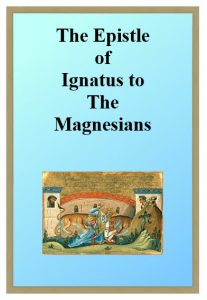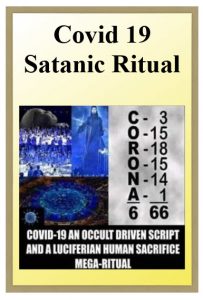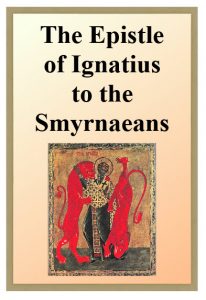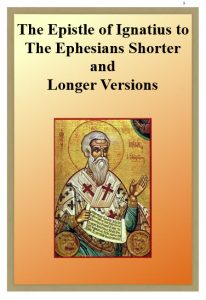1:1 Ignatius, who is also Theophorus, unto her that hath found mercy in the bountifulness of the Father Most High and of Jesus Christ His only Son;
1:2 to the church that is beloved and enlightened through the will of Him who willed all things that are, by faith and love towards Jesus Christ our God;
1:3 even unto her that hath the presidency in the country of the region of the Romans, being worthy of God,
1:4 worthy of honour, worthy of felicitation, worthy of praise, worthy of success, worthy in purity, and having the presidency of love, walking in the law of Christ and bearing the Father’s name;
1:5 which church also I salute in the name of Jesus Christ the Son of the Father;
1:6 unto then, that in flesh and spirit are united unto His every commandment, being filled with the grace of God without wavering, and filtered clear from every foreign stain;
1:7 abundant greeting in Jesus Christ our God in blamelessness.
1:8 Forasmuch as in answer to my prayer to God it hath been granted me to see your godly countenances, so that I have obtained even more than I asked;
1:9 for wearing bonds in Christ Jesus I hope to salute you, if it be the Divine will that I should be counted worthy to reach unto the end;
1:10 for the beginning verily is well ordered, if so be I shall attain unto the goal, that I may receive mine inheritance without hindrance.
Download Tag: Scripture
The Epistle of Ignatius to Polycarp
THE EPISTLE OF IGNATIUS TO POLYCARP (often abbreviated Ign. Poly.) is an epistle attributed to Ignatius of Antioch, a second-century bishop of Antioch, and addressed to Polycarp, the bishop of Smyrna. It was written during Ignatius’ transport from Antioch to his execution in Rome.
Composition
See also: Ignatius of Antioch § Epistles
To Polycarp is one of seven epistles attributed to Ignatius that are generally accepted as authentic. In 5th century, this collection was enlarged by spurious letters.
It is clear that To Polycarp was written soon before the martyrdom of Ignatius, but it is uncertain when precisely this martyrdom occurred. Tradition places the martyrdom of Ignatius in the reign of Trajan, who was emperor of Rome from 98 to 117 AD. While many scholars accept the traditional dating of Ignatius’ martyrdom under Trajan, others have argued for a somewhat later date. Richard Pervo dated Ignatius’ death to 135-140 AD, and British classicist Timothy Barnes has argued for a date some time in the 140’s AD.
The Epistle of St. Ignatus to Polycarp
Apostolic Fathers (Lightfoot)
1:1 Ignatius who is also Theophorus, unto Polycarp who is bishop of the church of the Smyrnaeans or rather who hath for his bishop God the Father and Jesus Christ, abundant greeting.
1:2 Welcoming thy godly mind which is grounded as it were on an immovable rock, I give exceeding glory that it hath been vouchsafed me to see thy blameless face, whereof I would fain have joy in God.
The Epistle of Ignatus to the Philadelphians
The Epistle of Ignatius to the Philadelphians (often abbreviated Ign. Phil.) is an epistle attributed to Ignatius of Antioch, a second-century bishop of Antioch, and addressed to the church in Philadelphia of Asia Minor. It was written during Ignatius’ transport from Antioch to his execution in Rome.
Composition
See also: Ignatius of Antioch § Epistles
Philadelphians is one of seven epistles attributed to Ignatius that are generally accepted as authentic. In 5th century, this collection was enlarged by spurious letters.
It is clear that Philadelphians was written soon before the martyrdom of Ignatius, but it is uncertain when precisely this martyrdom occurred. Tradition places the martyrdom of Ignatius in the reign of Trajan, who was emperor of Rome from 98 to 117 AD. While many scholars accept the traditional dating of Ignatius’ martyrdom under Trajan, others have argued for a somewhat later date. Richard Pervo dated Ignatius’ death to 135-140 AD, and British classicist Timothy Barnes has argued for a date some time in the 140’s AD.
Content
Ignatius warns the Philadelphians not to start any schisms within their church, but to stay unified and obey their bishops and presbyters:
The Epistle of Ignatus to the Magnesians
Apostolic Fathers (Lightfoot)
1:1 Ignatius, who is also Theophorus,
1:2 unto her which hath been blessed through the grace of God the Father in Christ Jesus our Saviour,
1:3 in whom I salute the church which is in Magnesia on the Maeander, and I wish her abundant greeting in God the Father and in Jesus Christ.
1:4 When I learned the exceeding good order of your love in the ways of God, I was gladdened and I determined to address you in the faith of Jesus Christ.
1:5 For being counted worthy to bear a most godly name, in these bonds, which I carry about, I sing the praise of the churches;
1:6 and I pray that there may be in them union of the flesh and of the spirit which are Jesus Christ’s,
1:7 our never-failing life-an union of faith and of love which is preferred before all things, and-what is more than all-an union with Jesus and with the Father;
1:8 in whom if we endure patiently all the despite of the prince of this world and escape therefrom, we shall attain unto God.
2:1 Forasmuch then as I was permitted to see you in the person of Damas your godly bishop and your worthy presbyters Bassus and Apollonius and my fellow-servant the deacon Zotion,
3:1 it becometh you also not to presume upon the youth unto him,all reverence, even as I have learned that the holy presbyters also have not taken advantage of his outwardly youthful estate, but give place to him as to one prudent in God;
Covid 19 – Satanic Ritual
GOD IS REVEALING TRUTH, DON’T MISS IT. YOUR LIFE and YOUR CHILDREN’S LIVES DEPEND ON IT! I am so excited to see how GOD is speaking to so many of us, the same message, but different parts. I have to tell you there is so much information coming forward that NO ONE can keep up with it. I know that since GOD told me to leave my job, because of what was coming, I have done nothing all day and night, every day, 24/7 but work on this website and the owner’s website. Of course I do stop to eat now and then, sleep a little when my eyes or body give out. I have gone shopping a few times. I stop to clean the kitchen when we just run out of dishes. Other than that, I am on here. It is impossible for one person even to cover one part of what is happening completely. There is just too much
The Epistle of Ignatius to The Smyrnaeans
Apostolic Fathers (Lightfoot)
1:1 Ignatius, who is also Theophorus,
1:2 to the church of God the Father and of Jesus Christ the Beloved, which hath been mercifully endowed with every grace,
1:3 being filled with faith and love and lacking in no grace, most reverend and bearing holy treasures;
1:4 to the church which is in Smyrna of Asia in a blameless spirit and in the word of God abundant greeting.
1:5 I give glory to Jesus Christ the God who bestowed such wisdom upon you;
1:6 for I have perceived that ye are established in faith immovable,
1:7 being as it were nailed on the cross of the Lord Jesus Christ,
1:8 in flesh and in spirit,
1:9 and firmly grounded in love in the blood of Christ,
1:10 fully persuaded as touching our Lord that He is truly of the race of David according to the flesh,
1:11 but Son of God by the Divine will and power,
1:12 truly born of a virgin and baptized by John that {all righteousness might be fulfilled} by Him,
1:13 truly nailed up in the flesh for our sakes under Pontius Pilate and Herod the tetrarch (of which fruit are we-that is, of His most blessed passion);
The Epistle of Ignatius to the Ephesians Shorter and Longer Versions
IGNATIUS, WHO IS ALSO CALLED THEOPHARUS, to the Church which is at Ephesus, in Asia, deservedly most happy, being blessed in the greatness and fullness of God the Father, and predestinated before the beginning[1] of time, that it should be always for an enduring and unchangeable glory, being united[2] and elected through the true passion by the will of the Father, and Jesus Christ, our God: Abundant happiness through Jesus Christ, and His undefiled grace. Ignatius, who is also called Theophorus, to the Church which is at Ephesus, in Asia, deservedly most happy, being blessed in the greatness and fulness of God the Father, and predestinated before the beginning[1] of time, that it should be always for an enduring and unchangeable glory, being united[2] and elected through the true passion by the will of God the Father, and of our Lord Jesus Christ our Saviour : Abundant happiness through Jesus Christ, and His undefiled joy.[3]
CHAP. I.–PRAISE OF THE EPHESIANS.
I have become acquainted with your name, much-beloved in God, which ye have acquired by the habit of righteousness, according to the faith and love in Jesus Christ our Saviour. Being the followers[4] of God, and stirring up[5] yourselves by the blood of God, ye have perfectly accomplished the work which was beseeming to you. For, on hearing that I came bound from Syria for the common name and hope, trusting through your prayers to be permitted to fight with beasts at Rome, that so by martyrdom I may indeed become the disciple of Him “who gave Himself for us, an offering and sacrifice to God,”[6][ye hastened to see me[7]]. I received, therefore,[8] your whole multitude in the name of God, through Onesimus, a man of inexpressible love,[9] and your bishop in the flesh, whom I pray you by Jesus Christ to love, and that you would all seek to be like him. And blessed be He who has granted unto you, being worthy, to obtain such an excellent bishop.
Trimorphic Protennoia
Information on Trimorphic Protennoia
JOHN D. TURNER WRITES (The Nag Hammadi Library in English, pp. 511-522): “Trimorphic Protennoia (‘The Three-formed [Divine] First Thought’) is, in its form, a Barbeloite treatise which has undergone both Sethian and Christian revisions. It is roughly contemporaneous with The Apocryphon of John (mid-second century C.E.), which it resembles in certain interesting ways, and is distinguished by a number of striking parallels to the Fourth Gospel and especially its prologue.”
Trimorphic Protennoia
Translated by John D. Turner
I AM PROTENNOIA, the Thought that dwells in the Light. I am the movement that dwells in the All, she in whom the All takes its stand, the first-born among those who came to be, she who exists before the All. She (Protennoia) is called by three names, although she dwells alone, since she is perfect. I am invisible within the Thought of the Invisible One. I am revealed in the immeasurable, ineffable (things). I am incomprehensible, dwelling in the incomprehensible. I move in every creature.
I am the life of my Epinoia that dwells within every Power and every eternal movement, and (in) invisible Lights and within the Archons and Angels and Demons, and every soul dwelling in Tartaros, and (in) every material soul. I dwell in those who came to be. I move in everyone and I delve into them all. I walk uprightly, and those who sleep, I awaken. And I am the sight of those who dwell in sleep.
The Tripartite Tractate
Information on The Tripartite Tractate
BIRGER A. PEARSON WRITES, “The Tripartite Tractate is the only completely preserved systematic treatise of Valentinian gnosis that has come down to us. It is a very lengthy treatise of eighty-eight pages–in the Nag Hammadi corpus only Zostrianos (VIII,1) is longer–and presents the entire mythological story of pleromatic origins, divine devolution leading to creation, and ultimate reintegration into the divine Pleroma. The text is divided by scribal decoration in the manuscript into three parts. Since no title is given to this treatise in the manuscript, the first editors called it Tractatus Tripartitus, or in English, Tripartite Tractate. The three main segments correspond to three major acts in the mythological drama. Part I (51,1-104,3) has an account of the primal Father and his aeons. Part II (104,4-108,12) deals with the creation of humanity and Adam’s fall. Part III (108,13-138,17) presents the Savior’s incarnation and human responses to his coming, culminating in the final restoration.” (Ancient Gnosticism, p. 184)
Einar Thomassen writes, “The importance of this tractate is above all that it contains a version of the Valentinian system that is distinctly Valentinian at the same time that it differs on many points from the well-known systems reported by the church fathers. For this reason, it helps us understand better what are the constant and indispensible features of the Valentinian systems and what are the constant and indispensable features of the Valentinian systems and what are individual and local variations.
The Treatise on The Resurrection
Information on The Treatise on The Resurrection
MALCOM L. PEEL WRITES (The Nag Hammadi Library in English, p. 52): “The importance of this short, eight-page, didactic letter lies in its witness to a distinctively unorthodox interpretation of Christian teaching about survival after death. By the late second century, the probable time of its composition, Christians – whether Gnostic or orthodox – were struggling with certain challenges and questions. Was such survival philosophical demonstrable (as Socrates had argued in the Phaedo)? What form might it take? (Immortality of the soul? Resurrection of the body? Reincarnation?) When would such survival be experienced? (At death? At Christ’s final return? Perhaps even before death?) The New Testament teaching was somewhat ambiguous on several of these points, though within the great church there seemed general agreement on at least two matters: the prototype and basis of hope for such survival was the resurrection of Jesus Christ, and the resurrection of individuals would entail their retention of personal identity.”









